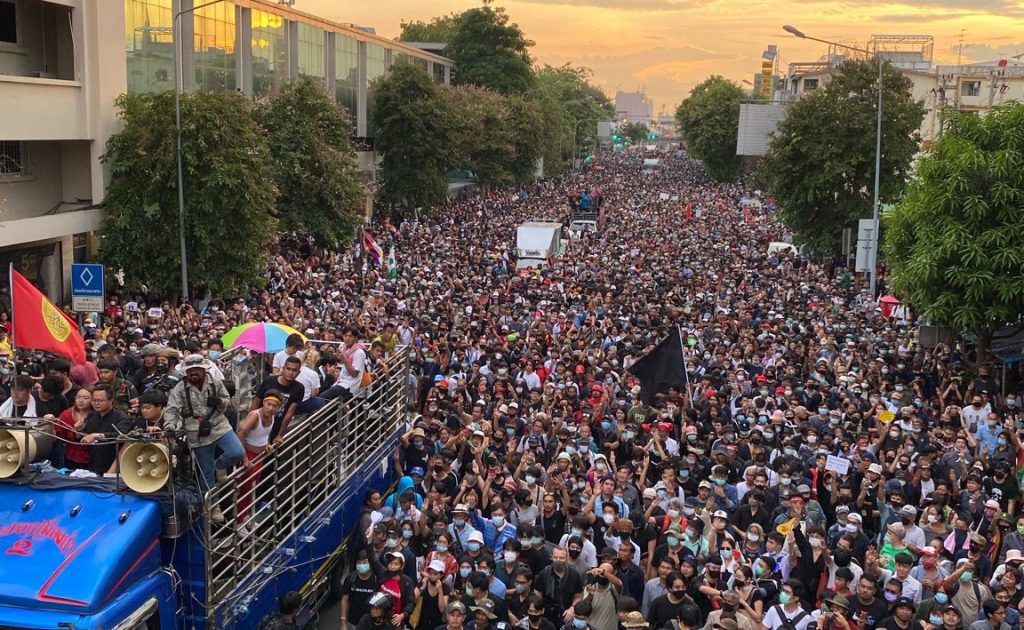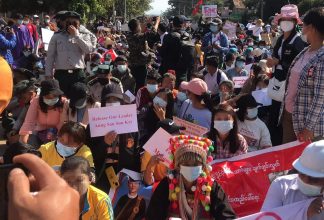Thai Police Should Immediately Stop Using Excessive Force Against Protesters

We, the undersigned organizations, condemn the Thai police’s unnecessary and excessive use of force against peaceful protesters marching to the national parliament in Bangkok on November 17, 2020. We are concerned that authorities could employ similar measures when facing protesters who have declared they will march to the Siam Commercial Bank headquarters on November 25.
On November 17, police set out barriers and barbed wire to prevent a peaceful march organized by pro-democracy movements from reaching the parliament. Protesters planned to protest outside the parliament as members of parliament and senators debated seven different proposals for constitutional amendments, including an amendment proposed by the lawyers’ non-governmental organization iLAW (Internet Law Reform Dialogue), which was supported by the People’s Movement and its allies. Police refused to let protesters through the barriers, and when the demonstrators acted to breach those barriers, police crowd control units used water cannons laced with purple dye and an apparent teargas chemical, as well as teargas grenades and pepper spray grenades, to forcibly disperse thousands of demonstrators, including students, some of whom are children. Water cannons were first used at approximately 2:25 pm and police continued their efforts to disperse protesters, with constant use of water cannons, teargas and pepper spray into the evening.
Police also failed to prevent violence between pro-democracy protesters and royalist “yellow shirts” near the Kiak Kai intersection, near the parliament. Initially, riot police separated the two groups. However, video posted on social media later showed police officers informing the royalist protesters that they would withdraw and seconds later they vacated their position between the two groups. During the ensuing skirmishes, both sides were filmed throwing rocks and wielding clubs. Live broadcasts included sounds that appeared to be gunfire.
The Erawan Medical Centre reported that there were at least 55 protesters injured, mostly from inhaling teargas. It also reported that there were six protesters who suffered gunshot wounds. The injured included children: a kindergartener and elementary school students.
Although some pro-democracy protesters engaged in violent conduct in responding to royalist protesters, we emphasize that the overwhelming number of protesters were entirely peaceful. Furthermore, we wish to emphasize that while specific participants of an assembly who engage in violence are subject to a response that is lawful, strictly necessary and proportionate, they also retain all other human rights including the right to life, to security of person and to freedom from torture and other cruel, inhuman or degrading treatment or punishment.
International human rights law, as expressed in the International Covenant on Civil and Political Rights (ICCPR), which Thailand acceded to in 1996, protects the rights to freedom of expression (article 19) and peaceful assembly (article 21). But Thai authorities have routinely enforced censorship and stifled public assemblies, meetings, and discussions about human rights, political reforms, and the monarchy’s role in society.
In General Comment 37, which sets out the content Thailand’s legal obligations in guaranteeing the right of peaceful assembly, the United Nations Human Rights Committee—the body responsible for interpreting and applying the ICCPR—made clear that there is a presumption in favor of considering assemblies to be peaceful. Isolated acts of violence by individuals should not be attributed to others, to the organizers, or to the assembly as such. While the right of peaceful assembly may in certain cases be limited, the onus is for the State to justify any restrictions, which must pass the tests of legality, legitimacy, and necessity and proportionality.
The Committee emphasized that “assemblies with a political message should enjoy a heightened level of accommodation and protection.” The Committee further highlighted the responsibility of governments to actively facilitate the enjoyment of the right to peaceful assembly, including by securing protest locations and protecting protesters “against possible abuse by non-State actors, such as interference or violence by other members of the public, counter-demonstrators and private security providers.” The Committee stressed that governments should, to the extent possible, allow protests within the “sight and sound” of their target audience or symbolic sites.
The Committee also said that law enforcement officials involved in policing assemblies “must respect and ensure the exercise of fundamental rights of organizers and participants.” Authorities should take on the basic approach of seeking to facilitate peaceful assemblies. Pursuant to Thailand’s obligations under articles 6, as interpreted by the Committee in General Comment 36 and Under the United Nations Basic Principles on the Use of Force and Firearms by Law Enforcement Officials and other international human rights standards, law enforcement may only use force when strictly necessary and to the extent required to achieve a legitimate policing objective.
In General Comment 37, the Committee further noted the indiscriminate effects of less-lethal weapons with wide-area effects, such as teargas and water cannons. Hence, the Committee said that “when such weapons are used, all reasonable efforts should be made to limit risks, such as causing a stampede or harming bystanders.” The 2020 United Nations guidance on less-lethal weapons in law enforcement further states that “water cannons should only be used in situations of serious public disorder where there is a significant likelihood of loss of life, serious injury, or the widespread destruction of property.” In addition, water cannons should only be used after law enforcement personnel have given warning and sought to “identify and isolate any violent individuals separately from the main assembly.” Authorities should also “not target a jet of water at an individual or group of persons at short-range owing to the risk of causing permanent blindness or secondary injuries if persons are propelled energetically by the water jet.” On the use of teargas, international standards provide that it should only be employed when necessary to prevent further physical harm and should not be used to disperse nonviolent demonstrations.
Given that children are participating in these protests, we also note that the Committee on the Rights of the Child emphasized in its comments on draft General Comment 37 that the State “has a positive duty to protect children’s rights and must at all times act with an awareness that children may be present at the assembly, and protect them from any harm that might be occasioned by law enforcement actions as well as harm caused by other participants in the assembly.”
On November 18, the spokesperson for United Nations Secretary-General António Guterres “expressed concern about the [human rights] situation in Thailand … it’s disturbing to see the repeated use of less lethal weapons against peaceful protesters, including water cannons … it’s very important that the government of Thailand refrain from the use of force and ensures the full protection of all people in Thailand who are exercising a fundamental peaceful right to protest.”
We call on the Thai government to respect, protect and fulfill the right of demonstrators to peacefully protest, in line with Thailand’s international obligations under the ICCPR and customary international law. Specifically, Thailand should:
- Permit the People’s Movement march to proceed on November 25 and allow for non-violent protesters, including those who are children, to peacefully protest in front of the Siam Commercial Bank headquarters.
- Protect the rights of protesters, including those who are children, in accordance with the Human Rights Committee’s General Comment No. 37 on the Right of Peaceful Assembly.
- Facilitate the exercise of the right to peacefully assemble and refrain from dispersing assemblies by using weapons, including less-lethal weapons, against protesters in line with the United Nations Basic Principles on the Use of Force and Firearms by Law Enforcement Officials and UN and other guidance on less-lethal weapons.
- Protect protesters, including those who are children, from violence and interference by non-State actors, while also protecting the rights of counter-demonstrators.
- Take steps to ensure accountability for rights violations associated with the government’s crackdown on the protest movement and to ensure that those whose rights have been violated enjoy the right to an effective remedy, as guaranteed under ICCPR article 2(3).
Download the full statement here.
Signed by:
Amnesty International
Article 19
ASEAN Parliamentarians for Human Rights
Asia Democracy Network
Asian Forum for Human Rights and Development (FORUM-ASIA)
Asian Network for Free Elections (ANFREL)
CIVICUS: World Alliance for Citizen Participation
Civil Rights Defenders
FIDH – International Federation for Human Rights
Fortify Rights
Human Rights Watch
International Commission of Jurists
Manushaya Foundation


